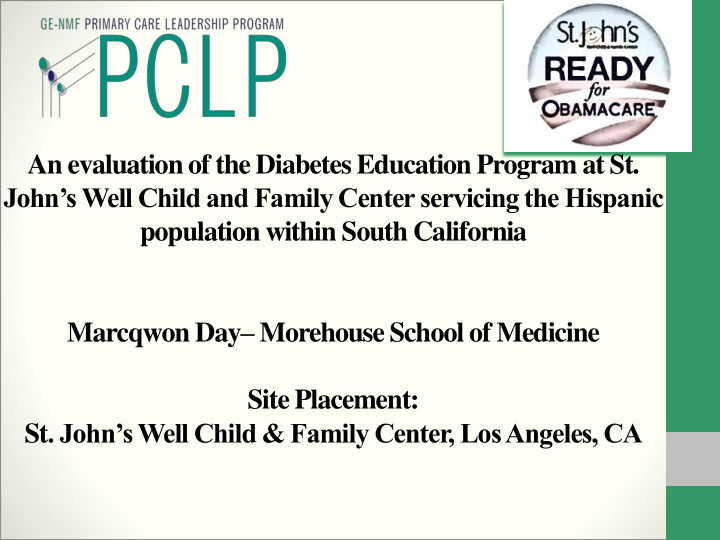



An evaluation of the Diabetes Education Program at St. John’s Well Child and Family Center servicing the Hispanic population within South California Marcqwon Day – Morehouse School of Medicine Site Placement: St . John’s Well Child & Family Center, Los Angeles, CA
Introduction: Diabetes Education Program • Ivy Marx (RD) & Maria Narnez (Diabetes Outreach Specialist) • Dr. Frayser Retirement • Three different site locations: • Williams (Wednesdays) • Magnolia (Thursdays) • Compton (Fridays) • Services population of southern California • Consist of: • Blood Glucose & Pressure Readings • Diabetic Lecture • Exercise through dance • HA1C & lipid panel checks (2-3 Months) w/ consultation • Heart healthy snack
Background: Los Angeles County (LAC) • According to Los Angeles County Department of Public Health, LAC exceeds the national percentage averages in many deleterious categories • Obesity, Cardiovascular Disease, Diabetes • Uninsured, Lack of access to healthcare and notorious meals • Moreover the territories that they service which includes South LAC show much more distressing statistics than its surrounding neighbors within LAC • South LAC shows more adverse statistics surrounding health outcomes including diabetes, cardiovascular disease, being overweight and obesity • Diabetes is the number 6 and 7 leading cause of death and premature death in LA County in the year 2005 with coronary heart disease being number 1 in both categories
Methodology • Needs Assessment • Focus groups • Williams and Compton, Week of 06/16/2013, Patient Question & Answer • Wind shield survey • Williams & Magnolia, Week of 06/10/2013, Notes & Pictures Recorded • Key informant interview • Ivy Marx, Dr. Hassanpour, Dr. Frayser, Maria Narnez ; Week of 06/04/2013 • Interventions • Diabetic Lectures (Weeks of 6/9/13 & 6/16/13 & 06/23/13) • Diabetes Overview ; Stress & Diabetes; Pre/Postest Given • Consultation (Weeks of 6/30/13 & 7/7/13) • Trending Graph Implementation (HA1C, BG, TAGs, HDL, LDL, Cholesterol) • Education Tab Development in Centricity (On Going) • Patient File, AVG Percentage Increase (CDC Measurement) • DVD Implementation (7/12/13) • American Association of Diabetes Edu. (AADE7 Model)
Results Stress & Diabetes Lecture Diabetes Overview Lecture 80 80 60 60 Pre-Test 40 Williams 40 Post-Test Compton 20 20 0 0 Williams Compton Magnolia Pre-Test Post-Test Pre-Test Post-Test Post-Test Number of Pre-Test Average Average Percentage Location Seminar Standard Average Standard Participants Percentage Change Deviation Percentage Deviation Williams Diabetes 19 58.9% 18.8 75.5% 11.5 +28.2% Overview Compton Diabetes 57.4% 20.5 69.1% 17.2 +20.4% 27 Overview Williams Stress & 21 48.3% 17.9 54.1% 22.4 +12% Diabetes Compton Stress & 43.8% 17 63.2% 17.6 +44.3% 31 Diabetes Magnolia Stress & 12 46.7% 15.6 66.7% 14.4 +42.8% Diabetes
Discussion • The Diabetes Education Program although very effective in helping their patients maintain stable HA1C levels had no measurable way to document how much their patients were indeed learning from the lectures provided through the program. • After analyzing the results of each test all averages increased from pre to posttest which shows that the patients were indeed capable and have been learning throughout their time within the Diabetes Education Program. • This helps in understanding why the patients within the DEP has had stable management of their HA1C levels in comparison to those not within the DEP at St. John’s . • I worked with the informaticist in creating a measurable way in how to document the learning outcomes from the patients through using percent average increase from pre to posttest for patients and this will be now recorded within Centricity.
Conclusion • According to the assessment, the Diabetes Education Program at St. John’s is well received by the patients and is effective in managing its patients’ chronic disease. • The need to introduce new forms of regular exercise and stress management that will help the patients maintain and improve their health will be addressed through partnership with a personal trainer/life coach and St. John’s to promote good health in their patients • The need to have other diabetic patients outside the education program will be addressed through the incorporation of a DVD.
Further Conclusions • This disc will include lectures regarding diabetes, nutrition tips, exercise routine, physician explanation of the common medications, blood glucose monitoring, and problem solving, and taking medication. (Click on video clip below) • In addition to this disc a personal trainer/life coach will work to address the need of stress management and new forms of physical exercise to patients within the Diabetes Education Program over the course of next year where the effectiveness will then be analyzed.
Recommendations • The key findings of the needs assessment reveals that the population of diabetic patients in LAC outside the DEP needs similar intervention due to the nutritional, educational, and medical challenges faced by the communities served by St, John’s. • Improvements however also need to be made to the Diabetes Education Program as well ranging from stress management, increase in space, regular exercise, greater structure, and physician replacement. • These issues imply that a core theme that is associated with most of the improvements needed within the Diabetes Education Program is staffing as well as space to house more patients.
Further Recommendations • Recommend that similar programs centered on chronic disease management be developed. • I also propose that these programs be opened up to not only the patients that have been diagnosed with disease, but also to those that are also at risk as well. • I believe that this would serve as a very effective way to help better manage the communities of Southern Los Angeles who are leading its surrounding neighbors in deleterious health outcomes
Recommend
More recommend